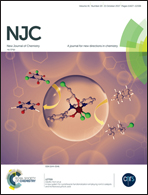Pore structure improvement of carbon aerogel and investigation of the supercapacitive behavior of a Co3O4 nanoball/carbon aerogel composite†
Abstract
In the present study, hybrid nanostructures of porous Co3O4 nanoball/carbon aerogel were prepared via the in situ growth of Co3O4 nanoballs with nanosized uniform structures within the pores of a pre-synthesized atmospheric pressure-dried highly mesoporous carbon aerogel. The three-dimensional structure of the carbon aerogel with appropriate electrical conductivity, high specific surface area and mesopore volume enabled the fabrication of an electrode with appropriate electrochemical performance when combined with the porous Co3O4 nanoball. This Co3O4 nanoball/carbon aerogel hybrid nanostructure exhibits a large specific capacitance of 350 F g−1 at the current density of 1 A g−1 in 6 M KOH electrolyte in a three electrode system. Furthermore, due to its special nanostructure, this electrode exhibits an energy density of 23.82 W h kg−1 at power density of 95.96 W kg−1 in 6 M KOH and an energy density of 19.44 W h kg−1 at power density of 76.2 W kg−1 in 2 M KOH. Cycling in the potential range of 0.0 to 1 V at a current density of 1 A g−1 in a symmetrical configuration (two-electrode system) exhibits an ascending capacitance trend with 210% of capacity retention after 6000 cycles. These prominent performance characteristics demonstrate the promising role of the prepared hybrid nanostructure for supercapacitor applications.


 Please wait while we load your content...
Please wait while we load your content...